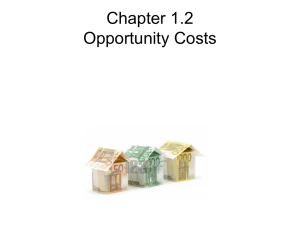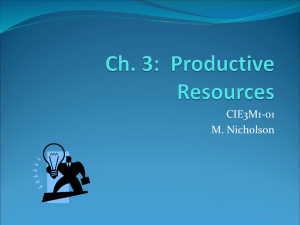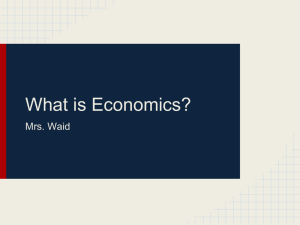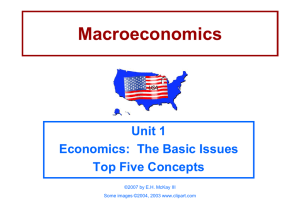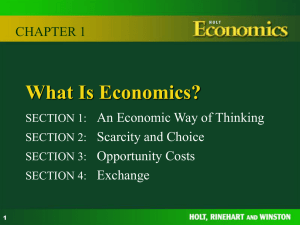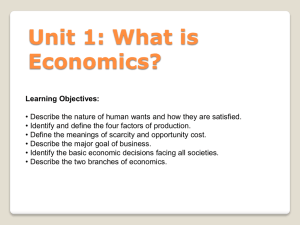OBJECTIVES: • Explain why scarcity and choice are basic problems
advertisement
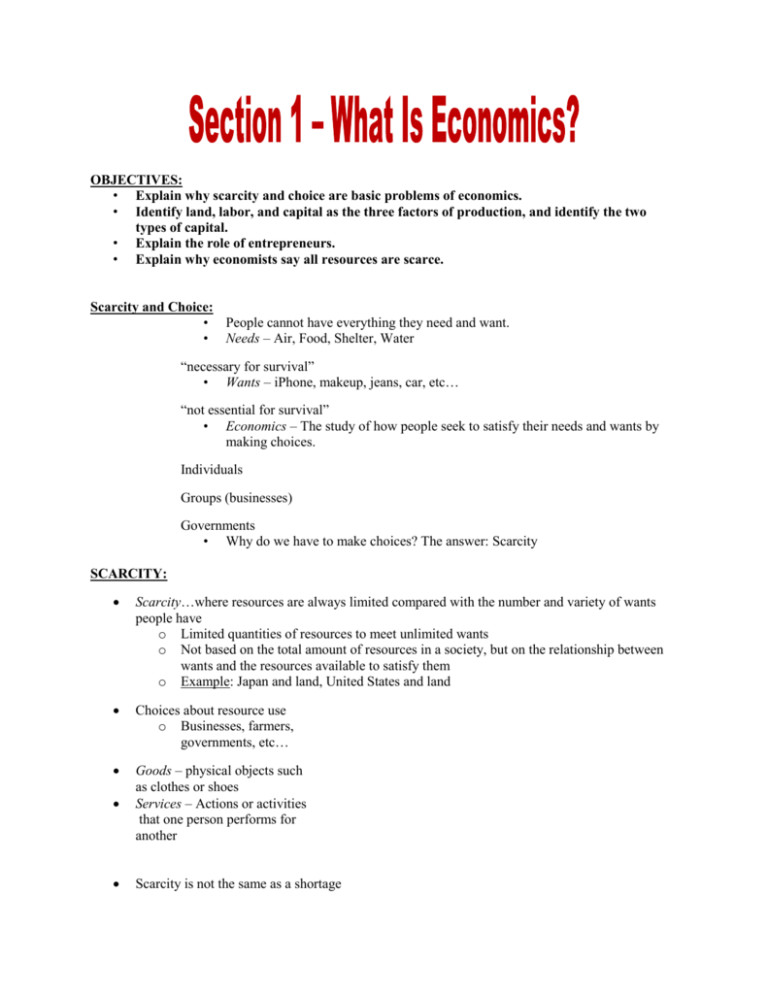
OBJECTIVES: • Explain why scarcity and choice are basic problems of economics. • Identify land, labor, and capital as the three factors of production, and identify the two types of capital. • Explain the role of entrepreneurs. • Explain why economists say all resources are scarce. Scarcity and Choice: • People cannot have everything they need and want. • Needs – Air, Food, Shelter, Water “necessary for survival” • Wants – iPhone, makeup, jeans, car, etc… “not essential for survival” • Economics – The study of how people seek to satisfy their needs and wants by making choices. Individuals Groups (businesses) Governments • Why do we have to make choices? The answer: Scarcity SCARCITY: Scarcity…where resources are always limited compared with the number and variety of wants people have o Limited quantities of resources to meet unlimited wants o Not based on the total amount of resources in a society, but on the relationship between wants and the resources available to satisfy them o Example: Japan and land, United States and land Choices about resource use o Businesses, farmers, governments, etc… Goods – physical objects such as clothes or shoes Services – Actions or activities that one person performs for another Scarcity is not the same as a shortage Shortage – a situation in which a good or service is unavailable o Where producers will not, or cannot, offer goods or services to consumers o Could be temporary or long term. Scarcity always exists. o Our needs and wants are always greater than the resource supply o Goods and services are scarce because they are all made from resources that are scarce. FACTORS OF PRODUCTION: Factors of production…The resources people have for producing goods and services to satisfy their wants o Economists…the people who study how economies work The three basic factors of production: Land, Labor, Capital Land – made up of the many natural resources that are needed to help produce goods and services (soil, minerals, water, timber, fish and wildlife, energy resources, etc…) Labor – time and energy, including the knowledge and skills required to work a job. Capital – anything produced in an economy that is saved to be used to produce other goods and services. – tools, buildings, or machines used to produce goods are used as capital, and are called capital goods – Money can also be capital, but only when it is not used for buying something now but is saved to be used for production sometime in the future Physical capital – all human made goods that are used to produce other goods and services (tools and buildings) Human capital – the knowledge and skills that a worker gains through experience and education Entrepreneurs – ambitious leaders who decide how to combine land, labor, and capital resources to create new goods and services. o They take risks to develop new ideas, start businesses, create new industries, and fuel market economies (Steve Jobs, Bill Gates) example: Shark Tank People in any economy face three major economic decisions: What goods and services should be produced, and how much of them? How should these goods and services be produced? Who will get the goods and services that are produced? In our economy, the people who own or can get the resources decide what to produce. 1. What and How Much to Produce In our economy, the people who own or can get the resources decide what to produce. • Any decision about what goods or services to produce is based on a prediction of what people will want to consume. • How much to produce is also decided by the owner of the resources. • The resources of labor, land, and capital must be combined in a process called production, in order to produce goods and services. • Example: Farmers produce food by combining soil, water, and sunlight (land) with seed and machinery (capital). They also use their knowledge, skills, time, and energy, as well as their workers (labor). • Distribution is the process by which goods and services are made available to the people who want them. Consumption is the act of buying or using goods and services. • • There are never enough resources in any society to produce all the goods and services people want. • People must make choices about which of their wants will be satisfied and which will not. • Cost and Benefits • Must look at the cost of each possible choice • The major cost is giving up the benefits you would have received from the next best alternative • Must also look at the benefits of each choice 2. How to Produce Goods and Services • In what way will land, labor, and capital be combined to produce the goods and services people want? • In making decisions about how to produce, people usually want to choose the combination of resources that will be the least costly. • This has lead to the growth of technology • The Role of Technology • Plays an increasingly important part in the decision that people make about how to produce goods and provide services. • Example: seeds which are engineered to produce larger crops, electronic advancements which gave us robots to use in factories, etc… • Computers keep records, make calculations, and speed up many jobs. 3. Who Will Get What Is Produced • People must find a way to decide how all the goods and services will be divided up. • Wants are always greater than the resources available to satisfy them…this leads to a very important and difficult choice of who gets what. • Should goods and services be divided equally among all people? • Should people receive goods and services on the basis of what they say they want? • Should a small group of people decide who is to receive which goods and services? • Should people who own more resources and produce more products get more goods and services than people who own or produce less? OBJECTIVES: Describe why every decision involves trade offs. Explain the concept of opportunity cost. Explain how peoiple make decisions by thinking at the margin. • All individuals, businesses, governments, and large groups of people make decisions that involve trade-offs. • Trade-off…an alternative that we sacrifice when we make a decision. • Individuals and trade-offs – ex. Spending time at work, means giving up time playing video games or playing sports • Businesses and trade-offs – ex. A farmer choosing to plant broccoli cannot use the same land to grow wheat. A factory that produces chairs instead of cabinets. • Society and trade-offs – ex. ‘Guns or Butter’ a country that decides to produce more military goods (“guns”) has fewer resources available to devote to consumer goods (“butter”) • Opportunity Cost…the most desirable alternative given up as the result of a decision. o Ex. A family that buys a computer cannot spend the money on a vacation. o The vacation is the OPPORTUNITY COST of the computer Your decision depends on the opportunity cost…whatever you were willing to sacrifice. o Sleep late or wake up early for a ski trip? o Sleep late or wake up early to eat your breakfast? o Sleep late or wake up early to study for a test? Trade-offs are all the alternatives that we give up whenever we choose one course of action over others. • • • • • The most desirable alternative given up as a result of a decision is known as opportunity cost. Always the second best choice for you is the opportunity cost Economists encourage us to consider the benefits and costs of our decisions. When you decide how much more or less to do, you are thinking at the margin. OBJECTIVES: Interpret a production possibilities curve. Demonstrate how a production possibilities curve shows efficiency, growth, and cost. Understand that a country’s production possibilities depend on its available resources and technology. • • • What is a production possibilities curve? How do production possibilities curves show efficiency, growth, and cost? Why are production possibilities frontiers curved lines? • • A Production Possibilities Curve (or graph) shows alternative ways that an economy can use its resources. The production possibilities frontier is the line that shows the maximum possible output for that economy. Efficiency: • Efficiency means using resources in such a way as to maximize the production of goods and services. • An economy producing output levels on the production possibilities frontier is operating efficiently. Growth: • Growth - If more resources become available, or if technology improves, an economy can increase its level of output and grow. • When this happens, the entire production possibilities curve “shifts to the right.” Cost: • A production possibilities graph shows the cost of producing more of one item. To move from point c to point d on this graph has a cost of 3 million pairs of shoes. • PPC’s will always have an inverse relationship: The more of this means the less of that. The Law of Increasing Costs: • The more we shift from one item to the other the more it costs • This is why the PPC’s have a bend • PPC’s can also show us what we value

